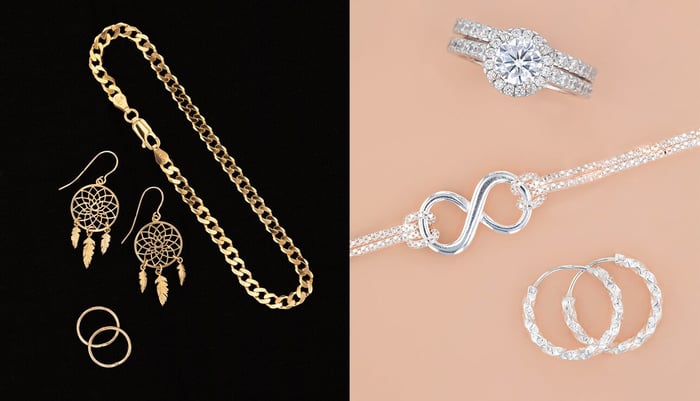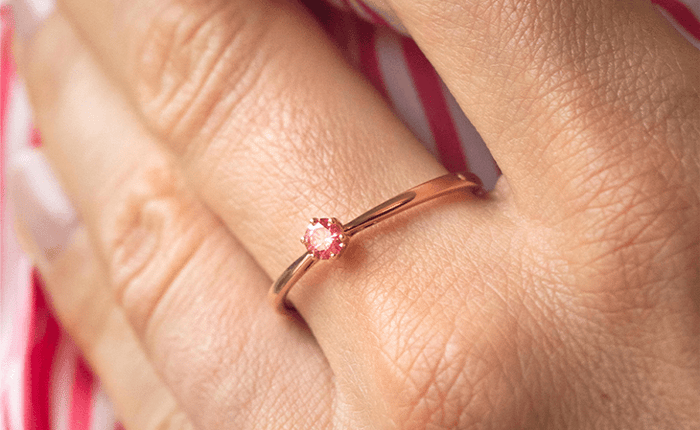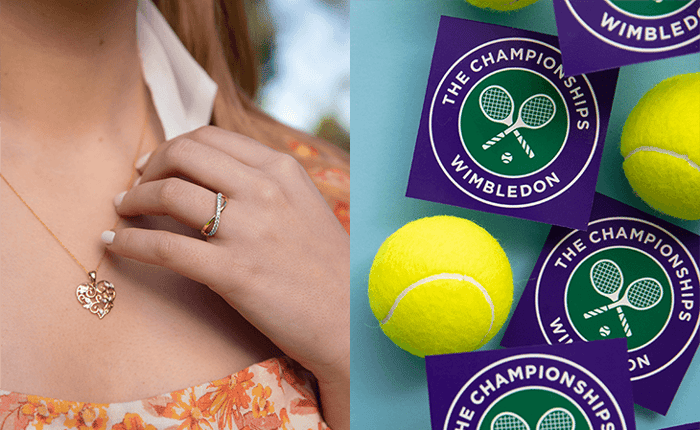There are so many different metal options when it comes to jewellery - so what is yellow gold and white gold?
If you ask people where gold comes from, most people will say that it comes from mines, or extracted from seawater - which is true, however, the true origin of the element predates the formation of the earth. Gold is a chemical element that is created during a supernova, or when neutron stars collide.
Gold is a traditional metal that has been used to make jewellery for centuries. The height of gold jewellery can be dated back to the Georgian and Victorian era, where gold was most popular in jewellery and other ornamentation including hued fabrics like silk and velvet. During this time, gold was set with precious stones such as diamonds, turquoise, ruby and sapphire, and was often decorated with elaborate engravings. While the earliest period of jewellery recorded in shops was in the mid-19th century, it can be seen as far back as 4000 BC in Eastern Europe.
Today, gold jewellery is especially popular, with the rich hues of warm sunny yellow and the cool tones of white gold, it is the metal of choice for many. Read on to find out about the difference between yellow gold and white gold so you can decide which is the best choice for you!
White Gold vs Yellow Gold:
- How they’re made
- Colour
- Durability and Maintenance
- Cost
- Pros and Cons of Yellow Gold
- Pros and Cons of White Gold

How They’re Made
In its purest form, gold is 24 carats. However, we are unable to use 24 carat gold for jewellery because it is too soft and cannot withhold the wear and tear of everyday activities. Therefore, gold jewellery is commonly seen in 9ct, 10ct, 18ct and 22ct varieties. Gold naturally has a classic yellow tone, therefore there are no additional elements that change its colour, however, gold is alloyed with metals such as copper, silver, palladium and nickel to improve its durability.
The process of making white gold begins by melting down yellow gold in a furnace. An alloy containing platinum or palladium is then added to the molten metal and mixed together. The alloy is then cooled and cast into ingots, which are then rolled into sheets or wire. These sheets are combined with an additional amount of yellow gold to create the final product: white gold jewellery.
Colour
Both yellow gold and white gold are beautiful materials that contain elements of gold. The biggest noticeable difference between the two is the colour - your choice will depend on personal preference.
Yellow gold features the traditional colour that you think of when you consider gold. It has a striking yellow tone that is warm, classic and looks great on almost every skin tone. The number of carats will determine and change how yellow the gold is. The higher the number of carats, the more yellow the gold. For example, an 18ct gold ring will be a more yellowy colour than a 9ct gold ring. Yellow gold jewellery compliments any style and colour of stone - the opportunities are endless.

White gold on the other hand has a cooler, white tone that resembles silver. White gold is a classic and a popular choice for many people due to its neutral tone. White gold looks best with cooler coloured stones like diamond, aquamarine and sapphire.

While we recommend keeping your yellow gold jewellery the same colour (ie; stick to 9ct gold across all your pieces), it is becoming more and more on trend to mix and match your yellow gold and white gold jewellery for a fashionable look.
Durability and Maintenance
It is important to note that yellow gold and white gold have different levels of durability. This is especially essential to consider if you work a lot with your hands, undertake activities that could damage your jewellery or are looking to wear it for many years.
Yellow gold has fewer alloys, and due to its high amount of gold, it is more prone to dents and scratches. You can maintain the brightness and clarity of gold jewellery with regular maintenance and polishing, however, if you are a very hands-on person this could prove to be a timely process. An advantage to yellow gold is that it is malleable and can be easily resized at a later date.
White gold on the other hand is made with more alloys, making it more durable and less prone to visible wear and tear. However, white gold still requires the same amount of maintenance to retain its shine and lustre. It is also important to note that those with sensitive skin may struggle to wear white gold jewellery due to the high metal content.
Learn more: Jewellery Care Guide

Cost
Jewellery is an expensive commodity, so it is important to be an informed shopper. The question about which is more expensive is not a straightforward one, there are many factors that play into the cost of yellow gold v. white gold. Typically, yellow gold and white gold are priced equally based on their gold content.
Pros and Cons of Yellow Gold
Pros
- Versatile yellow colour that looks great with a wide variety of different outfits. Suits any stone, style and aesthetic.
- Malleable material means that you can get it resized in the future easily.
- Does not tarnish, fade or change colour over time.
Cons
- Prone to dents and scratches, requires consistent maintenance to maintain clarity.
Pros and Cons of White Gold
Pros
- Due to the high alloy content, those with metal allergies should avoid wearing white gold.
- Highly durable and resistant to scratches and dents.
- Beautiful colour that is neutral and works well with cooler coloured stones.
Cons
- More difficult to get resized due to the high alloy content.
- Requires consistent maintenance to maintain clarity.

Both yellow gold and white gold are beautiful materials that are suitable for all kinds of jewellery. They do not tarnish or fade and are made to last a lifetime. There are many factors to consider when choosing between the two. Nothing beats the classic warmth of traditional yellow gold, while white gold is durable and is a stunning alternative for those who prefer a cooler tone.












